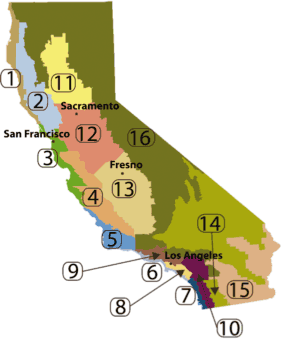Many federal, state and local government entities now include cool roofs in their building codes, green building standards and energy efficiency programs. However, requirements for cool roofs differ by national or state climate zone in some cases so be sure to refer to the California and U.S. climate zone maps below to understand the requirements in your area.
 |
California has 16 climate zones for the purposes of state codes and standards
In California, all new or replacement low-slope roofs are required by the building energy efficiency standards (Title 24) to be cool roofs, as are steep-slope roofs in several California climate zones. The California Energy Commission (CEC) developed handouts with information on Cool Roofs:
- 2022 Energy Code Hand out on Cool Roofs for Nonresidential buildings, hotels and motels: The prescriptive approach requires that roofs meet minimum aged SR and TE efficiencies or the minimum SRI for newly constructed buildings, additions, and alterations where more than fifty percent or 2,000 square feet, whichever is less, of the roof is replaced, recovered, or recoated, with some exceptions.
- 2022 Energy Code Hand out on Cool Roofs for Multifamily buildings: The prescriptive approach requires that roofs meet minimum aged SR and TE efficiencies or the minimum SRI for newly constructed buildings, additions, and alterations where more than fifty percent or 2,000 square feet, whichever is less, of the roof is replaced, recovered, or re-coated, with some exceptions.
The Cool Roof Rating Council (CRRC) is an independent, non-profit organization that maintains a third-party rating program, which rates and publishes a roof product’s radiative properties (solar reflectance and thermal emittance). Once a product is rated, the results are published on their online Rated Products Directory, which is a great resource to check to see whether roofing products comply with Title 24 or other codes and standards.
CRRC tests products when they are both new and aged. Aged products are weathered outside for three years. The weathered rating will indicate how the roof products’ radiative properties change when exposed to sun, soil, wind, rain and other natural elements. Many building codes and utility rebates specify the weathered rating because some products become less reflective over time, thus become less effective at conserving energy.
California’s Energy Code in Title 24, Part 6 of the Building Standards Code regulates state building energy efficiency requirements for residential and nonresidential buildings.
Keep in mind that these requirements are only the minimum criteria for compliance; many California cities have gone above and beyond to exceed these requirements in their local planning efforts – see what local initiatives some California cities are undertaking.
And to find products that meet the required minimum values for solar reflectance, thermal emittance, and solar reflectance index (listed in the table above), you can browse the Cool Roof Rating Council’s Rated Products Directory.
